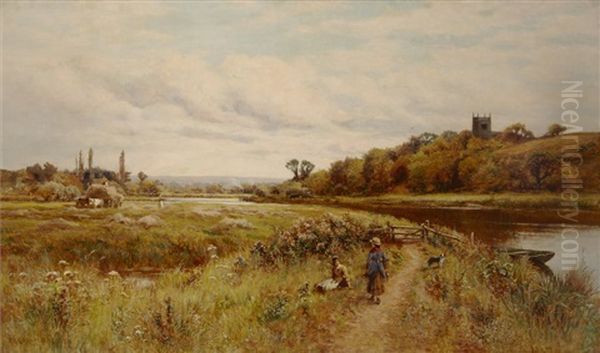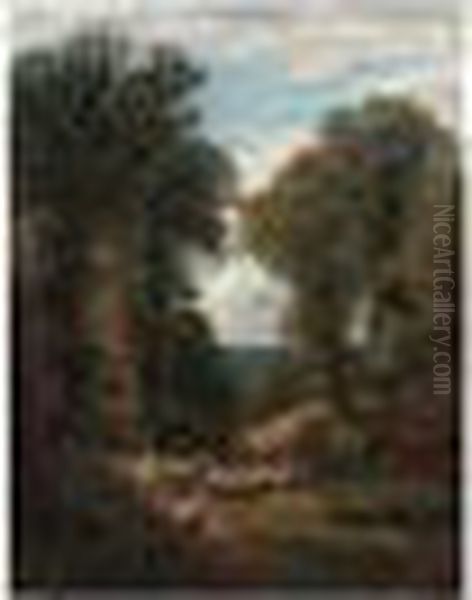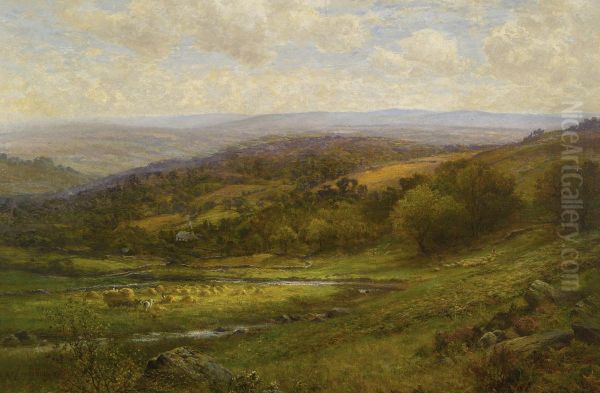Alfred Augustus Glendening Sr. stands as a significant figure in the rich tapestry of British Victorian art. Primarily celebrated as a landscape painter, his works captured the idyllic beauty and serene charm of the British countryside, particularly the river valleys and rural expanses of Southern England, Wales, and Scotland. Active during a period of immense social and industrial change, Glendening's art offered a comforting, picturesque vision of nature that resonated deeply with his contemporaries and continues to find appreciation today. His journey from a railway clerk to a respected artist, exhibiting regularly at prestigious institutions, highlights a dedication to his craft and a keen sensitivity to the natural world.
From Railway Clerk to Royal Academy Exhibitor
Born in Greenwich, London, around 1840, Alfred Augustus Glendening's early life did not immediately point towards an artistic career. His initial profession was that of a railway clerk, a position reflective of the burgeoning industrial age in Britain. However, the allure of art proved stronger than the routine of office work. Driven by a passion for painting, Glendening made the pivotal decision to leave his clerical job and dedicate himself entirely to becoming an artist. This transition, likely occurring in his early twenties, marked the beginning of a long and productive career focused on capturing the landscapes he loved.
His commitment quickly bore fruit. By the early 1860s (sources suggest dates like 1861 or 1864/65 for his debut), Glendening began exhibiting his work in London. This relatively early start for a self-made artist in the competitive Victorian art scene was notable. His talent was soon recognized, leading to regular appearances at major London exhibitions. From 1865 onwards, his paintings became a familiar sight at the prestigious Royal Academy of Arts, a key venue for establishing an artist's reputation. He continued to exhibit there consistently for nearly four decades, until around 1903.
Artistic Style: Realism, Light, and Atmosphere

Glendening's artistic style is firmly rooted in the Victorian tradition of landscape painting, characterized by a detailed realism combined with an emphasis on atmospheric effects. He possessed a remarkable ability to render the subtleties of the natural world – the intricate patterns of foliage, the reflective qualities of water, and the delicate play of light and shadow across the land. His approach was meticulous, ensuring that topographical features were recognizable, yet he imbued his scenes with a gentle, often idealized, sensibility.
His handling of light was particularly adept. Glendening often favoured the soft, diffused light of early morning or late afternoon, casting a warm, golden glow over his compositions. Skies frequently feature prominently, often depicted with soft blue hues and gentle white clouds, contributing to the overall sense of tranquility and peace that pervades much of his work. Water, especially rivers like the Thames, was a recurring and masterfully handled element, captured with convincing reflections and a sense of gentle movement.
While detailed, his realism generally avoided the intense, almost microscopic focus associated with some Pre-Raphaelite landscape work (like early Millais or specific studies by William Holman Hunt). Instead, Glendening aimed for a broader, more picturesque effect, balancing detail with overall harmony. His colour palette tended towards soft, naturalistic greens, blues, and earthy tones, enhancing the calm and inviting mood of his paintings.
A distinctive feature of Glendening's work is the frequent inclusion of small human figures or animals within the landscape. These are rarely the primary focus but serve to animate the scene, add narrative interest, and provide a sense of scale. Children might be seen playing by a riverbank, anglers patiently waiting for a catch, cattle grazing peacefully in water meadows, or swans gliding gracefully on a lake. These elements reinforce the idyllic, pastoral vision, suggesting a harmonious coexistence between humanity and nature.
Favourite Haunts: The Thames, Southern England, and the Highlands
Glendening's oeuvre reveals a deep affection for specific British landscapes, which he returned to paint time and again. The River Thames was a particularly favoured subject. He captured numerous views along its course, especially through the picturesque stretches of the Thames Valley, depicting scenes at locations like Hampton, Sunbury, and Henley. These river scenes often showcase his skill in rendering water, reflections, and the lush vegetation lining the banks.

The counties of Southern England, notably Surrey and Sussex, provided ample inspiration with their rolling hills, wooded lanes, and charming villages. These landscapes, easily accessible from London, represented the quintessential English countryside for many Victorians. Glendening excelled at capturing the gentle beauty of these areas, often focusing on tranquil rural life, harvest scenes, and quiet country paths. Norfolk, particularly the Broads with its distinctive waterways and windmills, also featured in his work, as seen in paintings like Belaugh on the Bure.
Seeking more dramatic scenery, Glendening also travelled to Wales and Scotland. The rugged mountains, serene lochs (lakes), and expansive vistas of the Scottish Highlands offered a contrast to the gentler southern landscapes. His paintings of these regions often convey a sense of grandeur and wildness, sometimes featuring Highland cattle, a popular motif in Victorian Scottish painting, also depicted by artists like Joseph Farquharson or Horatio McCulloch. Similarly, the Welsh countryside provided subjects rich in picturesque potential. This breadth of locations demonstrates his versatility and his commitment to exploring the diverse beauty of the British Isles.
Notable Works and Market Recognition
While Glendening produced a substantial body of work, several paintings and themes stand out as representative. Works depicting the Thames, such as The Thames at Hampton or views near Sunbury, exemplify his mastery of river scenery and atmospheric light. Paintings titled generically, like A Surrey Lane or English Harvest Scene, capture the essence of the southern English countryside he so often portrayed. His depictions of the Norfolk Broads, like Belaugh on the Bure, Norfolk, showcase his ability to handle the unique light and landscape of East Anglia.
His skill extended to capturing specific moments and activities within the landscape. Landscape With Cattle And Haystacks, for instance, is typical of his pastoral scenes, blending animal life with agricultural settings under expansive skies. The inclusion of figures, whether working or at leisure, adds a human dimension to the natural world.
Glendening achieved considerable success during his lifetime, reflected not only in his frequent exhibitions but also in the market for his work. His paintings were popular with Victorian collectors who appreciated their technical skill and reassuringly beautiful subject matter. This popularity has endured, and his works continue to be sought after at auction. The mention of a painting titled The Grand Finale achieving a price of $130,130 at auction (though details of the specific sale require verification) indicates the significant value his major works can command, confirming his status as a commercially successful artist of his time.
Exhibition History and Professional Standing

Alfred Augustus Glendening Sr.'s professional standing was solidified through his consistent presence at London's major art exhibitions. His debut in the early 1860s was followed by decades of regular participation, demonstrating both his productivity and the acceptance of his work by the art establishment. The Royal Academy of Arts was a primary venue, with records showing his exhibits spanning from 1865 to 1903. Exhibiting at the RA was crucial for visibility and critical reception in the Victorian art world.
Beyond the RA, Glendening also showed his work at other important institutions. These included the British Institution (though this closed in 1867, suggesting early career participation) and the galleries at Suffolk Street, home to the Society of British Artists (SBA), which later gained the prefix 'Royal' (RBA). Exhibiting across these different venues exposed his work to a wide audience of critics, patrons, and fellow artists. Sources indicate he exhibited well over one hundred works across these platforms during his career, a testament to his prolific output and sustained engagement with the London art scene. This regular exhibition activity cemented his reputation as one of the reliable and popular landscape painters of the Victorian era.
The Glendening Artistic Legacy: Father and Son
The Glendening name in art is associated not only with Alfred Augustus Sr. but also with his son, Alfred Illman Glendening (often cited as Alfred Glendening Jr., c. 1861–1907). Alfred Jr. followed directly in his father's footsteps, becoming a landscape painter himself. He studied under his father and adopted a very similar artistic style and choice of subject matter. Both father and son favoured picturesque views of the Thames, the English countryside, and sometimes coastal scenes, executed with a comparable attention to detail and atmospheric effect.
This similarity in style and subject matter, combined with the shared name, has occasionally led to confusion in attributions. Works by the son are sometimes mistakenly assigned to the father, and vice versa. However, Alfred Jr. established his own reputation, also exhibiting at the Royal Academy and other London venues during his shorter career. The existence of this artistic lineage, with the son continuing the father's tradition, speaks to a familial dedication to the art of landscape painting and further cemented the Glendening name within the context of late Victorian art. Alfred Augustus Sr.'s influence as both a father and a teacher was clearly profound.
Context: Landscape Painting in Victorian Britain
Alfred Augustus Glendening Sr. worked during a period when landscape painting enjoyed immense popularity in Britain. The Victorian era witnessed a flourishing of the genre, driven by several factors. The legacy of earlier masters like John Constable and J.M.W. Turner had elevated landscape painting's status. The expansion of the railway network made previously remote areas of the British Isles accessible to artists and tourists alike, fostering a greater appreciation for national scenery.
Furthermore, rapid industrialization and urbanization led many to feel a sense of nostalgia for a perceived simpler, rural past. Landscape paintings offered an escape, presenting idealized visions of the countryside as a place of peace, beauty, and traditional values. The influential critic John Ruskin championed "truth to nature," encouraging artists to observe the natural world closely, which resonated with the detailed approach favoured by many Victorian painters, including Glendening.
The rise of a prosperous middle class created a new market for art. These patrons often preferred modestly sized, accessible subjects like landscapes, which could be displayed in domestic settings. Glendening's work, with its appealing subject matter, technical proficiency, and manageable scale, fit perfectly into this market. He was part of a large cohort of artists catering to this demand, including figures like Benjamin Williams Leader, George Vicat Cole, Henry H. Parker, and members of the Williams family of painters (such as Sidney Richard Percy), all known for their popular and often highly detailed depictions of British scenery. While distinct in their individual styles, they collectively shaped the dominant trends in Victorian landscape art.
Contemporaries and Artistic Milieu
Alfred Augustus Glendening Sr. operated within a vibrant and diverse artistic milieu. While direct collaborations are not widely documented, he undoubtedly interacted with and was aware of numerous contemporaries through shared exhibition spaces like the Royal Academy. His realistic yet picturesque style can be situated alongside other successful landscape painters of the era.
Benjamin Williams Leader (B.W. Leader) was perhaps one of the most famous landscape painters of the later Victorian period, known for his evocative Worcestershire scenes and silvery birch trees. George Vicat Cole specialized in lush Surrey landscapes and harvest scenes, often sharing a similar pastoral sensibility with Glendening. Henry H. Parker also focused on southern English river scenes and farmland, often with a bright, sunlit palette. The aforementioned Sidney Richard Percy, part of the Williams dynasty, painted detailed views of Wales and Scotland, overlapping with Glendening's geographical interests.
While Glendening's style was generally calmer and less dramatic than the moonlit urban or coastal scenes of Atkinson Grimshaw, they were contemporaries navigating the same art market. Similarly, Myles Birket Foster, though primarily a watercolourist, captured an idealized vision of English rural life and childhood that shares a thematic kinship with the figures often found in Glendening's oils.
Looking towards Scotland, artists like Horatio McCulloch were established figures depicting Highland grandeur, while Joseph Farquharson became famous for his snow scenes with sheep, often imbued with dramatic light. Though perhaps not direct influences, the work of the French Barbizon School painters like Jean-Baptiste-Camille Corot or Théodore Rousseau, with their emphasis on direct observation and naturalistic rendering of landscape, formed part of the broader European context for realism in landscape art during the 19th century. Glendening’s distinctly British interpretation, however, focused more on picturesque detail and serene atmosphere than the Barbizon's often more rugged or tonal approach.
Legacy and Art Historical Assessment
Alfred Augustus Glendening Sr.'s place in art history is that of a highly competent and successful exponent of Victorian landscape painting. He may not have been a radical innovator who dramatically altered the course of art, like Turner before him or the Impressionists abroad. However, he masterfully captured a particular vision of the British landscape that held enormous appeal for his contemporaries and remains attractive today. His work embodies many key characteristics of the era's taste: a love for detailed representation, a sentimental attachment to the countryside, and an appreciation for atmospheric effects and natural beauty.
His paintings serve as valuable documents of the landscapes of Victorian Britain, albeit often seen through an idealized lens. They reflect the era's complex relationship with nature – a source of solace and national pride in a time of rapid change. His technical skill, particularly in rendering water and light, was considerable, and his compositions are typically well-balanced and harmonious.
While perhaps overshadowed in broader art historical narratives by artists associated with more avant-garde movements, Glendening holds a secure position within the specific context of British Victorian art. His prolific output, consistent exhibition record, and enduring market appeal attest to his significance during his lifetime. For collectors and enthusiasts of traditional British landscape painting, his work continues to be admired for its craftsmanship, charm, and evocative portrayal of a bygone era. His contribution lies in his ability to translate the quiet beauty of the British Isles into paintings that offered, and still offer, moments of peaceful contemplation. The uncertainty surrounding his exact death date (often cited as c. 1910/11, though the provided text also mentions 1921) does not diminish the substantial body of work he left behind.
Conclusion
Alfred Augustus Glendening Sr. was more than just a painter of landscapes; he was a visual poet of the Victorian countryside. His journey from railway clerk to respected artist is a story of dedication, while his paintings of the Thames, the rolling hills of Southern England, and the majestic scenery of Wales and Scotland provide a lasting testament to his skill and sensitivity. Through his detailed realism, masterful handling of light, and inclusion of gentle human touches, he created works that celebrated the enduring beauty of nature. As a key figure within the popular tradition of Victorian landscape painting, Glendening captured an image of Britain that resonated deeply with his time and continues to evoke a sense of tranquil charm for viewers today. His legacy persists in his canvases, offering timeless glimpses into the serene landscapes of the 19th century.